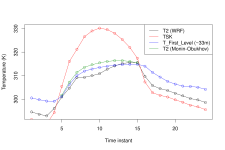Hello,
I've run some real simulations of a deep convective boundary layer and I am encountering some issues with the diagnosed T2 variable - I was expecting T2 to be bounded between the ground temperature (TSK) and and the first model temperature (T evaluated at first model level), following Monin-Obukhov similarity theory, but it's actually lower than T evaluated at the first model level in the afternoon, which does not make any physical sense. This problem happens clearly with the MYNN surface layer scheme (option 5). I am using the unified Noah land-surface model (option 2). Is that a known issue of the surface layer scheme or am I missing something? Is the final T2 diagnosed by the surface layer scheme or by the land surface model (I tried to look in the code but it's overwritten quite a few times and it's hard to get a handle on what's the final value for T2)?
Thanks for any insights you may give!
Paolo
I've run some real simulations of a deep convective boundary layer and I am encountering some issues with the diagnosed T2 variable - I was expecting T2 to be bounded between the ground temperature (TSK) and and the first model temperature (T evaluated at first model level), following Monin-Obukhov similarity theory, but it's actually lower than T evaluated at the first model level in the afternoon, which does not make any physical sense. This problem happens clearly with the MYNN surface layer scheme (option 5). I am using the unified Noah land-surface model (option 2). Is that a known issue of the surface layer scheme or am I missing something? Is the final T2 diagnosed by the surface layer scheme or by the land surface model (I tried to look in the code but it's overwritten quite a few times and it's hard to get a handle on what's the final value for T2)?
Thanks for any insights you may give!
Paolo


